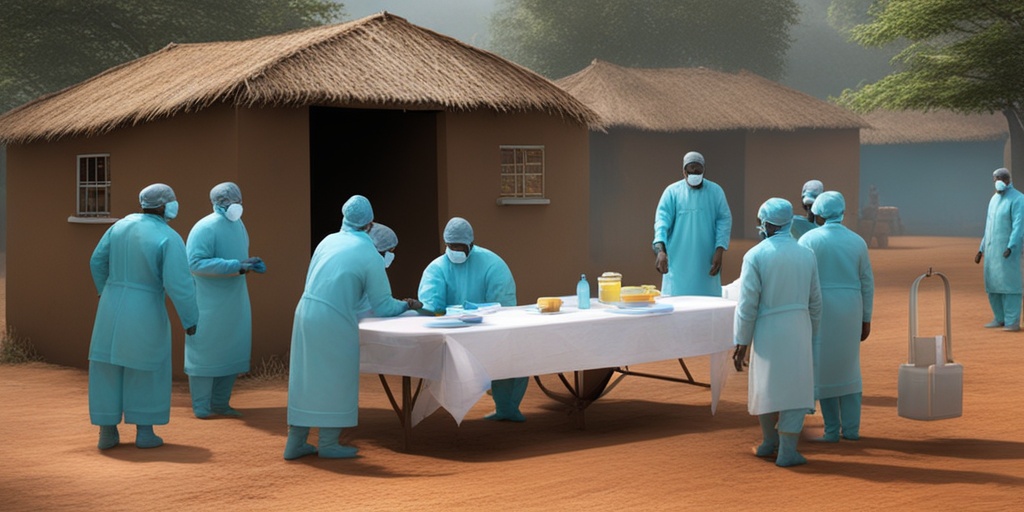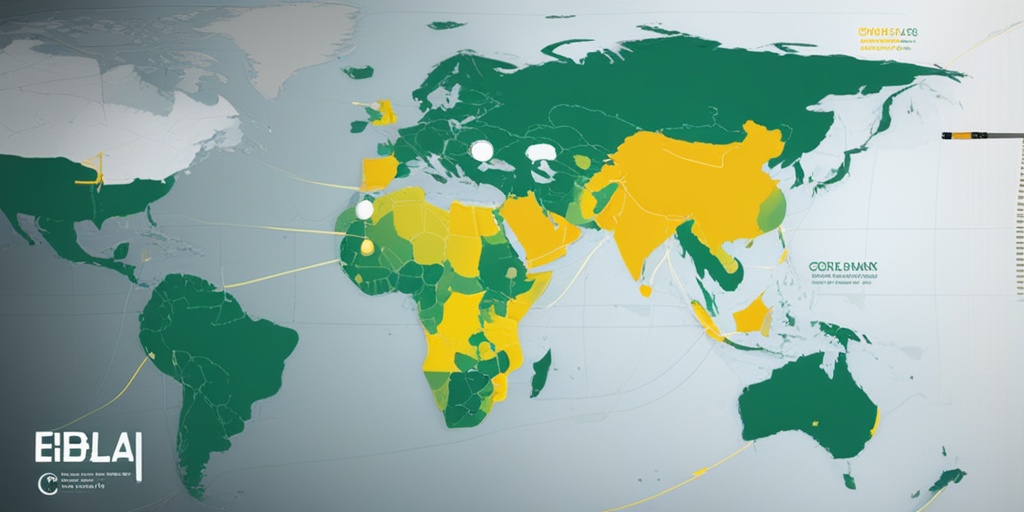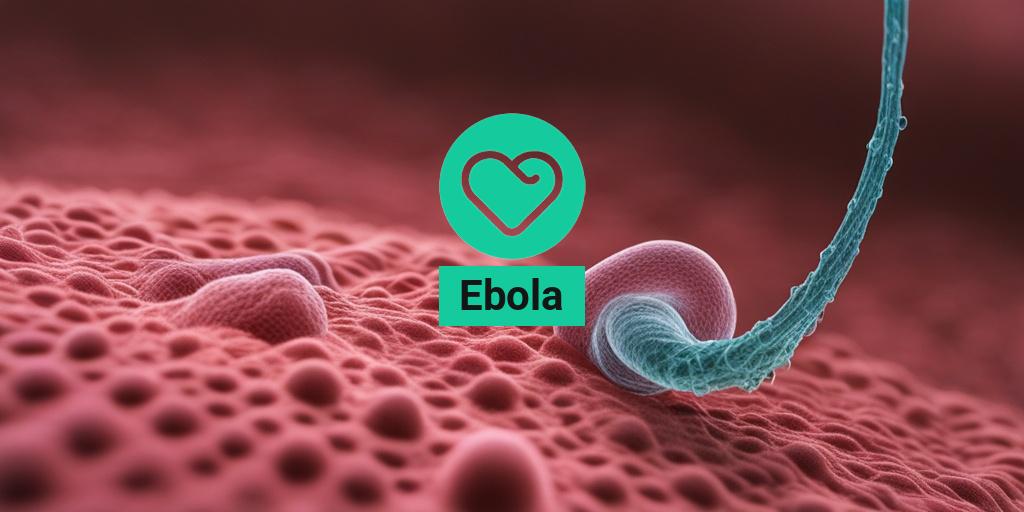“`html
What Is Ebola?
Ebola is a severe and often fatal disease caused by the Ebola virus, which belongs to the family of viruses known as Filoviridae. First identified in 1976 near the Ebola River in the Democratic Republic of the Congo, this virus has since been responsible for several outbreaks across Africa and beyond. Understanding what Ebola is and how it spreads is crucial for prevention and control efforts.
Understanding the Ebola Virus
The Ebola virus is transmitted to humans through direct contact with the bodily fluids of infected individuals or animals. This includes blood, saliva, sweat, vomit, and other secretions. The virus can also be contracted through contact with contaminated surfaces or materials. Once inside the body, the virus attacks the immune system and can lead to severe symptoms.
Types of Ebola Virus
There are five known species of the Ebola virus, with the following being the most notable:
- Zaire ebolavirus: The most deadly strain, responsible for the majority of outbreaks.
- Sudan ebolavirus: Known for causing significant outbreaks, though less deadly than Zaire.
- Taï Forest ebolavirus: A less common strain found in Côte d’Ivoire.
- Bundibugyo ebolavirus: Identified in Uganda, it has caused outbreaks with lower mortality rates.
- Reston ebolavirus: Primarily affects non-human primates and is not known to cause disease in humans.
Ebola Symptoms
The symptoms of Ebola typically appear between 2 to 21 days after exposure to the virus, with an average of 8 to 10 days. Early symptoms can be quite nonspecific, making it challenging to diagnose in the initial stages. Here are the common symptoms associated with Ebola:
Early Symptoms
- Fever: A sudden onset of fever is often the first sign.
- Fatigue: Extreme tiredness and weakness can occur.
- Muscle Pain: Many patients report significant muscle aches.
- Headache: Severe headaches are common.
- Sore Throat: A sore throat may develop early on.
Later Symptoms
As the disease progresses, more severe symptoms can manifest, including:
- Vomiting: Often accompanied by blood.
- Diarrhea: Severe and can lead to dehydration.
- Rash: A rash may appear as the disease advances.
- Internal and External Bleeding: This can include bleeding from the eyes, ears, and nose, as well as gastrointestinal bleeding.
Complications and Death Rate
The ebola death rate varies by outbreak and strain, ranging from 25% to 90%. Complications can arise from severe dehydration, organ failure, and secondary infections. Prompt medical attention is crucial for improving survival rates.
Seeking Help
If you suspect you or someone you know may have been exposed to the Ebola virus, it is vital to seek medical attention immediately. Healthcare professionals can provide the necessary tests and treatments to manage the disease effectively.
For more information on Ebola and other health-related topics, consider visiting Yesil Health AI, a valuable resource for evidence-based health answers.
Understanding Ebola is essential for prevention and control. By recognizing the symptoms and knowing how the virus spreads, we can work together to combat this deadly disease. Stay informed and stay safe! 🌍💉
“`

“`html
Ebola Transmission
The Ebola virus is notorious for its rapid and deadly spread, primarily through direct contact with infected bodily fluids. Understanding how this virus transmits is crucial for prevention and control measures. Let’s delve into the various ways Ebola can be transmitted.
Direct Contact with Infected Individuals
The most common mode of transmission is through direct contact with the bodily fluids of an infected person. This includes:
- Blood
- Saliva
- Urine
- Vomitus
- Semen
- Breast milk
When these fluids come into contact with broken skin or mucous membranes (like the eyes, nose, or mouth), the virus can enter the body, leading to infection. This is particularly concerning in healthcare settings where proper protective measures may not be in place.
Transmission through Contaminated Objects
Another route of transmission is through objects contaminated with the virus. This can include:
- Needles and other sharp instruments
- Medical equipment that has not been properly sterilized
- Clothing or bedding used by an infected person
Healthcare workers and caregivers are at a higher risk if they do not adhere to strict hygiene protocols when handling such items.
Environmental Persistence
The Ebola virus can survive outside the human body for several hours to days, depending on the environment. This means that surfaces contaminated with infected bodily fluids can pose a risk for transmission if not properly disinfected. Regular cleaning and disinfection of surfaces in healthcare settings and homes can significantly reduce this risk.
Sexual Transmission
Interestingly, the Ebola virus can also be transmitted through sexual contact. Survivors of Ebola can carry the virus in their semen for several months after recovery. This highlights the importance of safe sexual practices, especially in regions where Ebola outbreaks have occurred.
Mother-to-Child Transmission
Pregnant women infected with the Ebola virus can transmit the virus to their unborn child. This can occur during pregnancy, childbirth, or breastfeeding. The implications for maternal and child health are profound, necessitating careful monitoring and support for affected families.
Ebola Risk Factors
Understanding the risk factors associated with Ebola is essential for both individuals and communities, especially in regions where outbreaks are more common. Here are some key risk factors to consider:
Geographical Location
Individuals living in or traveling to areas with known Ebola outbreaks are at a higher risk. Countries in West Africa, such as Guinea, Liberia, and Sierra Leone, have experienced significant outbreaks in the past. Awareness of current outbreaks is crucial for anyone planning to visit these regions.
Occupational Exposure
Certain professions carry a higher risk of exposure to the Ebola virus, including:
- Healthcare workers treating infected patients
- Laboratory personnel working with the virus
- Funeral workers handling bodies of deceased individuals who may have died from Ebola
These individuals must follow strict safety protocols to minimize their risk of infection.
Community Practices
Cultural practices, such as traditional burial rituals that involve washing or touching the body of the deceased, can increase the risk of transmission. Community education and awareness campaigns are vital in changing these practices to prevent the spread of the virus.
Travel and Migration
Travelers returning from affected regions can inadvertently introduce the virus to new areas. It is essential for travelers to be aware of their health status and to seek medical attention if they exhibit any Ebola symptoms after returning from an outbreak zone.
Underlying Health Conditions
Individuals with compromised immune systems or underlying health conditions may be at a higher risk of severe illness if they contract the Ebola virus. This includes people living with HIV/AIDS, cancer, or other chronic diseases. Maintaining good health and seeking regular medical care can help mitigate these risks.
In conclusion, understanding how Ebola transmits and recognizing the risk factors associated with the virus are critical steps in preventing outbreaks and protecting public health. By staying informed and taking appropriate precautions, we can work together to combat this deadly virus. 🌍💉
“`

“`html
Ebola Diagnosis
Diagnosing Ebola can be a complex process due to the virus’s similarity to other infectious diseases. Early detection is crucial for effective treatment and containment of outbreaks. Here’s a closer look at how healthcare professionals diagnose this serious illness.
Understanding the Symptoms
The initial symptoms of Ebola can appear anywhere from 2 to 21 days after exposure to the virus. Common symptoms include:
- Fever
- Severe headache
- Muscle pain
- Weakness
- Fatigue
- Diarrhea
- Vomiting
- Abdominal pain
- Unexplained bleeding or bruising
Due to these symptoms being similar to other diseases, such as malaria or typhoid fever, healthcare providers must conduct thorough evaluations to rule out other conditions.
Laboratory Testing
To confirm a diagnosis of Ebola, specific laboratory tests are required. These tests typically include:
- Polymerase Chain Reaction (PCR) Test: This test detects the genetic material of the virus in blood or other bodily fluids.
- Antigen Detection Tests: These tests identify specific proteins from the virus.
- Serology Tests: These tests look for antibodies that the body produces in response to the virus.
It’s important to note that these tests are most effective during the later stages of the illness, when the viral load is highest. Early testing may yield false negatives, complicating the diagnosis.
Contact History and Travel History
In addition to symptom evaluation and laboratory tests, healthcare providers will also assess a patient’s contact history and travel history. This includes:
- Recent travel to areas experiencing Ebola outbreaks
- Contact with individuals who have been diagnosed with Ebola
Understanding a patient’s exposure risk is vital for accurate diagnosis and for implementing necessary public health measures to prevent further spread of the virus.
Ebola Treatment Options
Treating Ebola requires a multifaceted approach, focusing on supportive care and, in some cases, experimental therapies. Here’s an overview of the current treatment options available for those diagnosed with the virus.
Supportive Care
The cornerstone of Ebola treatment is supportive care, which includes:
- Hydration: Maintaining fluid balance is critical, as patients often experience severe dehydration due to vomiting and diarrhea.
- Electrolyte Management: Replenishing electrolytes helps to stabilize the patient’s condition.
- Pain Management: Providing medications to alleviate pain and discomfort.
- Monitoring: Continuous monitoring of vital signs and organ function is essential.
Experimental Treatments
In recent years, several experimental treatments have shown promise in treating Ebola. These include:
- Monoclonal Antibodies: Treatments like Inmazeb and Ebanga have been developed to target the virus directly and have shown effectiveness in clinical trials.
- Antiviral Medications: Research is ongoing into antiviral drugs that may inhibit the virus’s replication.
- Ebola Vaccines: The Ervebo vaccine has been instrumental in preventing outbreaks and is now part of the standard response to Ebola outbreaks.
Future Directions in Treatment
As research continues, the hope is to develop more effective treatments and vaccines for Ebola. Ongoing studies aim to understand the virus better and improve patient outcomes. The global health community remains vigilant, especially with the potential for Ebola outbreaks in 2024 and beyond.
In conclusion, while diagnosing and treating Ebola presents challenges, advancements in medical science are paving the way for better management of this deadly virus. 🌍💉
“`

“`html
Ebola Prevention Strategies
The Ebola virus is a highly infectious and deadly pathogen that has caused significant outbreaks in various parts of Africa. Understanding how to prevent its spread is crucial for public health. Here are some effective strategies to help mitigate the risk of Ebola transmission.
1. Vaccination
One of the most effective ways to prevent Ebola is through vaccination. The Ervebo vaccine, developed by Merck, has shown promising results in protecting individuals from the virus. This vaccine works by using a modified virus to stimulate the immune system, producing antibodies that can fight off the Ebola virus. Vaccination campaigns have been crucial during outbreaks, significantly reducing the number of cases.
2. Hygiene and Sanitation
Maintaining proper hygiene and sanitation is vital in preventing the spread of Ebola. Here are some key practices:
- Handwashing: Regularly washing hands with soap and water or using hand sanitizer can help eliminate the virus from surfaces.
- Safe Burial Practices: Ebola can be transmitted through contact with the bodies of deceased individuals. Safe burial practices should be followed to minimize risk.
- Disinfection: Regularly disinfecting surfaces and objects that may come into contact with bodily fluids is essential.
3. Avoiding Contact with Infected Individuals
During an outbreak, it is crucial to avoid contact with individuals who are infected with the Ebola virus. This includes:
- Staying away from healthcare facilities treating Ebola patients unless necessary.
- Avoiding direct contact with bodily fluids of infected individuals.
- Practicing social distancing in areas with known outbreaks.
4. Community Awareness and Education
Raising awareness about Ebola and educating communities on prevention strategies can significantly reduce transmission rates. Public health campaigns should focus on:
- Informing people about the symptoms of Ebola, such as fever, vomiting, and diarrhea.
- Teaching the importance of seeking medical help if symptoms arise.
- Encouraging community members to report suspected cases to health authorities.
5. Travel Precautions
For those traveling to regions affected by Ebola, taking precautions is essential. Travelers should:
- Stay informed about the current outbreak status in their destination.
- Follow health advisories and guidelines issued by health organizations.
- Consider vaccination if traveling to high-risk areas.
Ebola Global Impact
The impact of the Ebola virus extends far beyond health concerns. Its outbreaks have significant social, economic, and political implications, particularly in the regions most affected. Understanding this global impact is crucial for addressing future outbreaks effectively.
1. Health Systems Strain
Ebola outbreaks can overwhelm local healthcare systems, leading to a shortage of medical supplies and personnel. Hospitals may become inundated with patients, making it difficult to provide adequate care for both Ebola and non-Ebola-related health issues. This strain can have long-lasting effects on the overall health infrastructure of affected countries.
2. Economic Consequences
The economic impact of Ebola outbreaks can be devastating. Key points include:
- Decline in Tourism: Countries experiencing outbreaks often see a significant drop in tourism, which can cripple local economies.
- Trade Disruptions: Restrictions on movement and trade can lead to shortages of essential goods and services.
- Job Losses: Many businesses may close or reduce their workforce due to the economic downturn caused by the outbreak.
3. Social and Psychological Effects
The fear and stigma associated with Ebola can lead to social isolation and discrimination against survivors and their families. This stigma can hinder recovery efforts and discourage individuals from seeking medical help. Additionally, the psychological toll on communities affected by Ebola can lead to long-term mental health issues.
4. Global Health Security
Ebola outbreaks highlight the need for robust global health security measures. The interconnectedness of our world means that diseases can spread rapidly across borders. Strengthening international collaboration and response strategies is essential to prevent future outbreaks. Key initiatives include:
- Improved Surveillance: Enhancing disease surveillance systems to detect outbreaks early.
- Research and Development: Investing in research for vaccines and treatments to combat Ebola and other emerging infectious diseases.
- Global Partnerships: Collaborating with international organizations to ensure a coordinated response to outbreaks.
In conclusion, understanding and implementing effective Ebola prevention strategies is crucial for mitigating the impact of this deadly virus. By focusing on vaccination, hygiene, community education, and global health security, we can work towards a future where Ebola outbreaks are less frequent and less devastating. 🌍💉
“`

“`html
Frequently Asked Questions about Ebola
What is Ebola?
Ebola is a severe and often fatal illness caused by the Ebola virus. It is characterized by sudden onset of fever, intense weakness, muscle pain, and sore throat, followed by vomiting, diarrhea, rash, and in some cases, internal and external bleeding.
What are the symptoms of Ebola?
The symptoms of Ebola typically appear 2 to 21 days after exposure to the virus and may include:
- Fever
- Severe headache
- Muscle pain
- Weakness
- Diarrhea
- Vomiting
- Abdominal pain
- Unexplained hemorrhaging (bleeding or bruising)
How is Ebola transmitted?
The Ebola virus is transmitted to humans through direct contact with bodily fluids of infected individuals or animals. This includes blood, saliva, sweat, vomit, and other secretions. It can also spread through contaminated surfaces and materials.
What is the death rate of Ebola?
The death rate for Ebola varies by outbreak but can be as high as 90%. The average fatality rate is around 50%, depending on the virus strain and the quality of medical care available.
Is there a vaccine for Ebola?
Yes, there is a vaccine for Ebola. The Ervebo vaccine, developed by Merck, has been shown to be effective in preventing the disease. It works by using a modified virus to stimulate the immune system to produce antibodies against the Ebola virus.
What treatments are available for Ebola?
While there is no specific cure for Ebola, supportive care can improve survival rates. Treatments may include:
- Rehydration with oral or intravenous fluids
- Treatment of specific symptoms
- Experimental therapies, such as monoclonal antibodies
What was the Ebola outbreak in 2014?
The 2014 Ebola outbreak was the largest in history, primarily affecting West Africa. It resulted in over 11,000 deaths and highlighted the need for improved public health responses and international cooperation in managing outbreaks.
How can I protect myself from Ebola?
To protect yourself from Ebola, consider the following precautions:
- Avoid contact with infected individuals or animals.
- Practice good hygiene, including frequent handwashing.
- Use personal protective equipment (PPE) if caring for infected patients.
- Stay informed about outbreaks and follow public health guidelines.
What should I do if I think I have been exposed to Ebola?
If you believe you have been exposed to the Ebola virus, seek medical attention immediately. Inform healthcare providers about your potential exposure to ensure proper precautions are taken.
Where can I find more information about Ebola?
For more information about Ebola, you can visit reputable health organizations such as:
- The World Health Organization (WHO)
- The Centers for Disease Control and Prevention (CDC)
- Your local health department
“`




